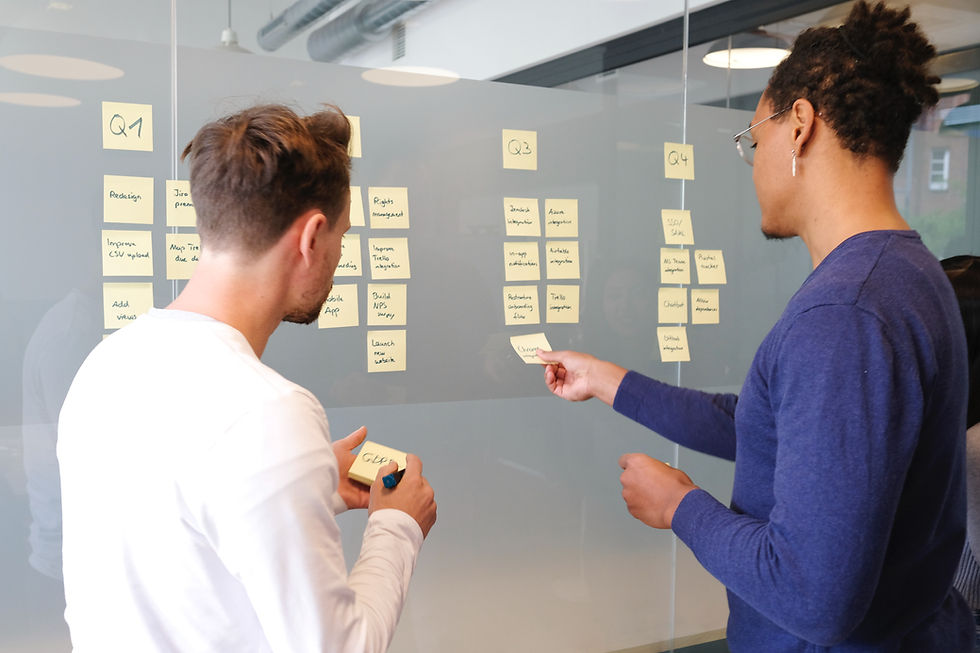The PI Planning Roadmap: The SAFe PI Planning Process
- Joel Oosthuizen

- Feb 17, 2022
- 3 min read
Updated: Feb 29, 2024
The SAFe PI Planning Process from 5 weeks out up to the PI Planning boundary is outlined below.

The SAFe PI Planning Process from 5 weeks out
5 Weeks to PI Planning
Lean Business cases & Epic Hypothesis communicated (new work) and evaluated (existing work)
Solution Management and Portfolio Management aligns on next priorities and socialize with Product Management (PM)
Solution Roadmaps are updated & socialized with PM
Continuous Exploration workshops conducted to build out features
WSJF updated by PM community (PM, Solution Management, Architects, PO’s, SMEs, Agile Team reps., RTEs etc.)
ART Vision & Roadmap updated
Socialization of Vision, Roadmaps and Features with the ARTs
Estimates updated as team refinements pan out
4 Weeks to PI Planning
Product Manager Align on the Vision
ART Roadmaps are updated based on Solution Roadmaps
Personas are associated with features
Top features are identified (or created) with Benefit Hypothesis and Acceptance Criteria
Features are sized with PMs, Architects, Team leads, SMEs etc. calculate and align on Capacity Allocation
Understand what features might slip into next PI
3 Weeks to PI Planning
Feature WSJF weighted and sequenced in Program backlog
Features are high level estimated
Architects update and socialize their Architectural Runway Roadmap
Product Mangers and Architects meet on Enabler Features and their WSJF
Re-sequence Backlog
Ideation / Inception Design Workshops to understand and decompose work to feed team backlogs
Feature Acceptance criteria is solid
2 Weeks to PI Planning
Features are understood and socialized with Agile Teams
Feature requester / Business Owner / PM describes why the feature is prioritized
Aligns teams on the benefit hypothesis and the acceptance criteria
Where incomplete, PM works with teams and stakeholders to augment them
Teams start slicing user stories from the features and populates the team backlogs
Teams refine the user stories and enabler stories with acceptance criteria and story points
Product Owner and team ensures they prioritize work across the spectrum of the capacity allocation model
1 Week to PI Planning
Teams have a good grasp on the user stories to be completed in next PI
Continuous refinement on the team backlog for next PI is in full motion
Discussions with other teams regarding user story clarity and dependencies (knowledge/skill/technical/build) takes place and is recorded in ADO to solidify the plan
User stories are estimated and meets the team’s definition of ready
Scrum Master and Team reviews the Team’s metrics and calculates the average velocity for the next iterations / PI
Capacity Allocation model is updated if required for upcoming PI
Week of PI Planning
Ensure current PI Objectives have their Actual Business Value set by Business Owners
Teams participate in Inspect and Adapt (I&A)
Scrum Master and Product Owner records the improvement items in the backlog for execution in upcoming PI (with size, acceptance criteria/ outcome on stories)
Improvement work earmarked for next PI is linked to Improvement feature on ART and Tagged “Continuous Improvement” item
Scrum Masters prepare metrics for current PI and publishes it on Dashboards
Scrum Master ensures next PI dashboards are ready for next PI
Scrum Master ensures team backlog and next iterations are ready in next PI (in ADO) and works with PO and team to evolve the plan
Definition of Done updated for next PI based on current PI learning
Closing current iteration, PI Objectives, Iteration Goals
Participate in PI Planning
After PI Planning
Capture all work in ADO with size of work
Link all work according to ADO standards
Ensure all PI Objectives have Business Value planned after discussing with Business Owners
Program Board updated with feature cards and dependencies
Ensure dependencies reflect in all affected teams
Risks are captured in ADO with all relevant fields updated (ROAM, Level, Owner (if known), etc.)
Agile teams perform their Iteration Planning and teams commit to their first iteration’s delivery
What's Next?
Join one of our SAFe courses to learn more about the PI Planning process.
Join our Newsletter by subscribing here.






